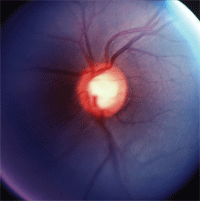Several reports have suggested that oxidative damage contributes to the development of glaucoma. A recent study tested this theory, and revealed a surprising finding: blacks have significantly higher levels of oxygen in the eye. This may explain why blacks have higher rates of ocular hypertension and glaucoma.

Blacks have higher levels of oxygen in the eye than whites, and therefore more oxidative damage, leading to glaucoma.
The study, published in the July issue of Archives of Ophthalmology, compared the amount of oxygen distribution (measured as partial pressure of oxygen, or PO2) in different regions in the eyes of 72 patients (53 white, 19 black) by introducing an optical oxygen sensor into the anterior chamber. Specifically, a surgeon positioned the tip of the probe for three measurements (near the central corneal endothelium, in the mid-anterior chamber and in the anterior chamber angle) in all patients (plus two other measurements for patients undergoing cataract extraction). All patients were undergoing cataract and/or glaucoma surgery.
The researchers discovered that black patients had significantly higher oxygen levels in the five locations compared with white patients. Adjusting for age increased the significance of this association.
Ben Gaddie, O.D., vice president of the Optometric Glaucoma Society, says that increased oxygen levels within the eye and ocular tissues may be a surrogate for oxidative stress and damage in eye diseases.
“In particular,” he says of this study, “the findings raise questions and reinforce suspicions that oxidative stress may be an IOP-independent cause of progressive glaucomatous optic neuropathy.”
The study researchers concluded that racial differences in oxygen levels in the human eye reflect an important difference in oxidative metabolism in the cornea and may reflect differences in systemic physiologic function. Moreover, increased oxygen or oxygen metabolites may increase oxidative stress, cell damage, intraocular pressure and the risk of developing glaucoma.
“We know that some 50% of glaucoma patients do not have elevated IOP, and this may be one of many factors leading to glaucomatous damage in the absence of elevated IOP,” Dr. Gaddie says.
Siegfried CJ, Shui YB, Holekamp NM, et al. Racial differences in ocular oxidative metabolism. Arch Ophthalmol. 2011 July;129(7):849-54.

